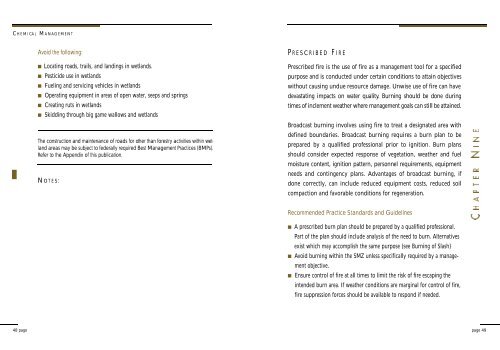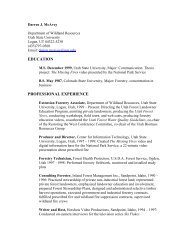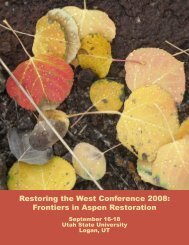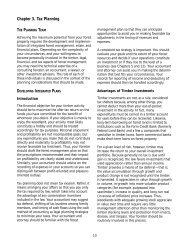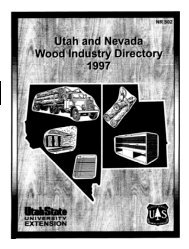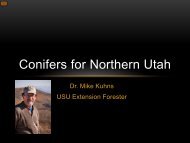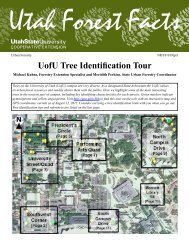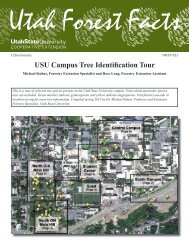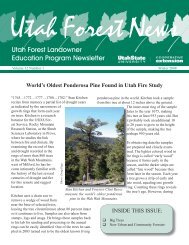A Technical Manual for Landowners, Loggers, and ... - Forestry
A Technical Manual for Landowners, Loggers, and ... - Forestry
A Technical Manual for Landowners, Loggers, and ... - Forestry
Create successful ePaper yourself
Turn your PDF publications into a flip-book with our unique Google optimized e-Paper software.
R O A D S, S K I D T R A I L S , L A N D I NG S & S T R E A M C R O S S I NG S<br />
R O A D S, S K I D T R A I LS , L A N D I NG S<br />
& S T R E A M C R O S S I NG S<br />
Slide Debris<br />
Slide debris can cause increased sediment loads in established roadway drainage<br />
systems as well as in established streams. Do not side cast removed material if there<br />
is a chance it will enter a stream. The cause of the slide needs to be evaluated. Under<br />
some circumstances, removal of the slide debris may make the situation worse by further<br />
undercutting the toe of the slope. In some instances, removal of some debris may<br />
be required <strong>and</strong> stabilization of the remaining material may prevent further problems.<br />
Consult an engineer <strong>for</strong> advice if problem persist.<br />
Skid Trails<br />
Skid trails are an important part of any <strong>for</strong>est transportation system. Skid<br />
trails are temporary travel ways or paths that are used by logging<br />
equipment to transport logs to a log deck or l<strong>and</strong>ing <strong>for</strong> loading onto trucks.<br />
While skid trails are not intended <strong>for</strong> over-the-road vehicles, their design <strong>and</strong><br />
location requires care <strong>and</strong> consideration <strong>and</strong> should follow all applicable<br />
FWQGs to prevent excessive erosion <strong>and</strong> sedimentation.<br />
Recommended Practice St<strong>and</strong>ards <strong>and</strong> Guidelines<br />
■ Use the fewest number of skid trails possible to limit soil disturbance.<br />
The use of designated skid trails is one way of limiting soil compaction<br />
<strong>and</strong> disturbance (see Figure 4.10). No more than 15% of the harvest area<br />
should be occupied by skid trails (see Table 4.2).<br />
■ Locate skid trails outside of Streamside Management Zones (SMZs).<br />
■ Use the most appropriate skidding system <strong>for</strong> the soil <strong>and</strong> terrain, (e.g.<br />
rubber-tires skidders, tractors, cable, etc).<br />
■ Avoid skidding directly up <strong>and</strong> down steep slopes <strong>for</strong> long distances.<br />
■ Avoid skidding patterns that concentrate or channel water <strong>and</strong> runoff.<br />
■ Where possible, keep skid trail grades less than 15%. Grades greater<br />
than 15% should not exceed 250 feet in length.<br />
■ Wh e re steep grades are unavoidable, break the grade <strong>and</strong> install<br />
drainage stru c t u res. When skidding is terminated, install appropriate<br />
water diversion devices such as cross ditches or water bars to pre v e n t<br />
channelization <strong>and</strong> erosion (see Table 4.3).<br />
Table 4.2<br />
Percentage of Harvest Area Covered by Skid Trails Assuming 10’ Width<br />
Skid Trail Spacing (ft) Area in Skid Trails %<br />
75 13.3<br />
100 10.0<br />
150 6.7<br />
200 5.0<br />
250 4.0<br />
Calculating Percent area in Skid Trails<br />
Skid Trail Width x 100<br />
Skid Trail Spacing<br />
Example: 10’ x 100=13.3%<br />
75’<br />
24 page page 25


